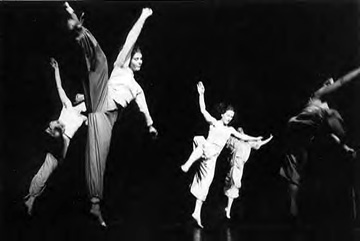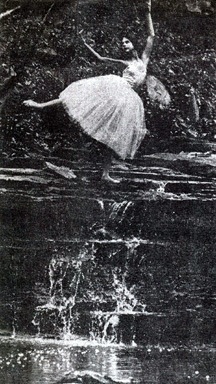In
Memoriam
Nina Fichter
by
Paul Parish
Copyright © 2004
by Paul Parish

It's tempting to say that the memorial was an earth-mother wail-in, for it put me in mind of the aims of the founders of modern dance: to get back to the deep roots of dance in ritual and emotion, to connect the living and the dead. If dancing at funerals and wakes is so much a thing of the past that my colleague Ann Murphy could lament only last week the flatness of her mother's wake, there was nevertheless no dearth of dancing at the Brava Theater for Nina Fichter's memorial, but much of it was light in spirit, and as haphazard as rock concerts used to be— cords all over the stage, lots of time taken up tuning instruments. When Lacota and Navajo put on their feathers, sang and danced for her, it was a very sweet incantation, evoking the breath of spring, falling waters, nothing heavy and earth-bound. Similarly, Chileans in exile (Grupo Raiz, with whom she'd danced at many fund-raisers for their cause) played their heavenly Andean music, children dressed like Isadora Duncan addressed her spirit, Taiko drums thundered….

I am incapable of being objective about Fichter. I knew her, took ballet class with her, performed with her; admired her commitment, loved her wit, hated the way she could harangue the audience (although sometimes it made converts—we heard last week from a Jewish woman who had moved to Israel to work for Palestinian rights, as a direct result of a performance I'd been embarrassed by, in which Fichter had read from the diaries of an Israeli nurse horrified by the wounded children of the other side).
 Wallflower
Order! What a name! The two words suggest intelligence and imagination,
discipline and devotion, anger and wit and a political outlook grounded
in the lives of women dancers. The troupe manifested all this in the courage
of what they attempted and what they brought off. They actually had a
great ballet about endangered species, and a heroic dance of defiance
in sign language, which was performed at the memorial , to the rhythms
of a feminist poem ("If I were I/ I would not submit/ to those things
things things that you say/…. I would vomit in your face").
As the verse is repeated— by every member of Dance Brigade who could
make it—the audience comes to memorize the words and gestures so
that, when the dance is repeated wordlessly one last time, you discover
you've learned to say "I would vomit in your face!" in sign
language, and by extension, we've learned to feel the inwardness of a
condition it had been assumed could not be asserted at all.
Wallflower
Order! What a name! The two words suggest intelligence and imagination,
discipline and devotion, anger and wit and a political outlook grounded
in the lives of women dancers. The troupe manifested all this in the courage
of what they attempted and what they brought off. They actually had a
great ballet about endangered species, and a heroic dance of defiance
in sign language, which was performed at the memorial , to the rhythms
of a feminist poem ("If I were I/ I would not submit/ to those things
things things that you say/…. I would vomit in your face").
As the verse is repeated— by every member of Dance Brigade who could
make it—the audience comes to memorize the words and gestures so
that, when the dance is repeated wordlessly one last time, you discover
you've learned to say "I would vomit in your face!" in sign
language, and by extension, we've learned to feel the inwardness of a
condition it had been assumed could not be asserted at all.
The Wallflower creative process was heated, angry, intense; they were all strong-minded, and the results were pithy, unmisunderstandable. The aim was to radicalize people, not to entertain the already converted. Their rhetoric has come to seem dated and it can be hard to remember that it was fresh once. But the work's in a tradition of high-minded idealism that included the movies of Eisenstein, and their aim was to bring to popular art their training in the high arts. Often I felt it was Fichter's dancing that best focussed the high tradition—she could look like Liberty leading the People, an image so truly placed, both in the picture and on the music, that you felt the presence of a grand ballerina. She could also be wildly funny, belting out "I'm a Woman, W-O-M-A-N" in a number about the radicalizing of a nice housewife during the days of Vietnam.
 They
all had real facility for classical dancing, but they went the other direction
and made "impure" dances, singing and talking and haranguing
the audience about non-dance issues, political issues—the struggles
of sweat-shop workers, or the Cherokees, or the mothers of Nicaragua whose
sons were disappearing. Fichter's unique contribution may have been her
intense consciousness of the dancer's body. I can still see her whirling,
shrieking over and over "I want to make the decisions about my body!"
Her own body was one in a million, with hips that would rotate to 90 degrees
and then some, feet like talons, long long legs, long arms, long neck,
small head—a silhouette like Suzanne Farrell's, who in fact was
the rep from the School of American Ballet who saw her in class in Cincinnati
and offered her the scholarship to SAB. Which she took, despite the fact
that her extraordinary flexibility was the result of a birth defect that
left her with an unfinished pelvis and a bladder that had to be replaced
with a catheter and a bag glued to her stomach.
They
all had real facility for classical dancing, but they went the other direction
and made "impure" dances, singing and talking and haranguing
the audience about non-dance issues, political issues—the struggles
of sweat-shop workers, or the Cherokees, or the mothers of Nicaragua whose
sons were disappearing. Fichter's unique contribution may have been her
intense consciousness of the dancer's body. I can still see her whirling,
shrieking over and over "I want to make the decisions about my body!"
Her own body was one in a million, with hips that would rotate to 90 degrees
and then some, feet like talons, long long legs, long arms, long neck,
small head—a silhouette like Suzanne Farrell's, who in fact was
the rep from the School of American Ballet who saw her in class in Cincinnati
and offered her the scholarship to SAB. Which she took, despite the fact
that her extraordinary flexibility was the result of a birth defect that
left her with an unfinished pelvis and a bladder that had to be replaced
with a catheter and a bag glued to her stomach.
I first saw her in Sally Streets' ballet class in Berkeley, which Dance Brigade took as a company class—she was dressed like a gypsy, in a long flounced skirt, bangles, a scarf tied round her head, hair on her legs—but she was completely turned out, and as her extensions reached out and up, she was the nearest thing to text-book correctness I'd ever seen that close-up.
Her last role was as the accordion-squeezing bag-lady narrator of the long-running Revolutionary Nutcracker Sweetie, a huge sprawling tasteless satire of Reagan-era greed (and the first "alternative" Nutcracker). It involved dancers from every conceivable corner of the community—trapeze dancers, bungie dancers, wheelchair dancers, Aztecs, snake dancers, capoieristas, Zulus, African-American kids turning back-flips whom Fichter had spotted on the street where she lived and brought into the show, an Argentine gaucho with a bolo—but since I performed in that show myself, I should probably stop here. O yes, Drosselmeyer made his entrance on a motorcycle. Fichter presided over all this and held it together. For a star, and she was a star, Fichter had a fantastic sense of the importance of community. Which probably came from the huge family that nurtured her and made her feel that, disabled though she was, if she wanted to dance, with a talent like hers friends and admirers would help her find a way.
Originally
published:
www.danceviewtimes.com
Volume 2, Number 4
January 26, 2004
Copyright ©2004 byPaul Parish
|
|
|